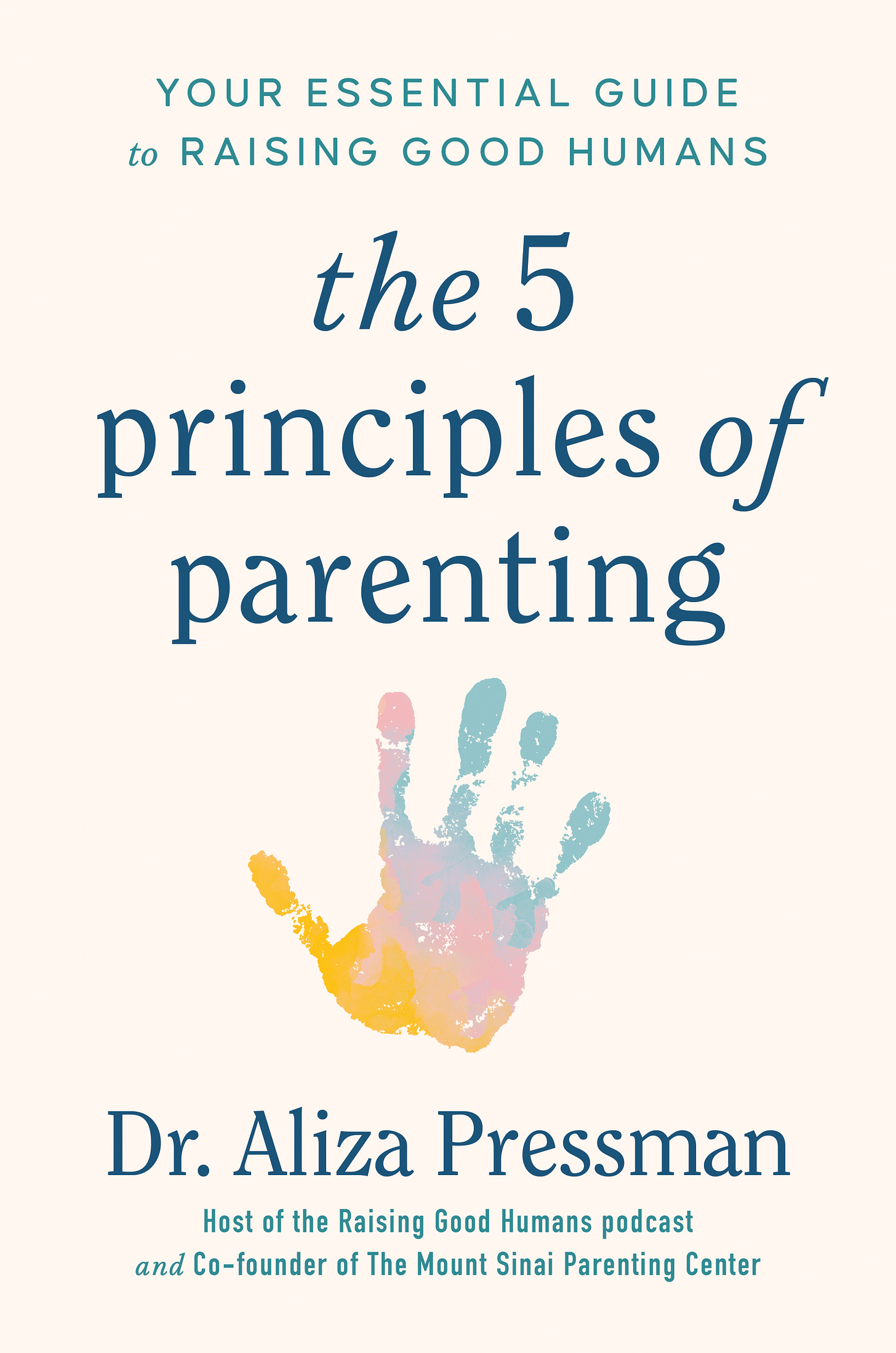Thanks for reading Raising Good Humans on Substack! My first book, The Five Principles of Parenting: Your Essential Guide to Raising Good Humans is now available for purchase here.

I love receiving subscriber questions (p.s. join my monthly ZOOM to get more questions answered on the spot)! This one is familiar to many - the phase of “NO!” No matter what type of approach we are taking in our parenting (i.e. how many limits or how much sensitivity we have), this is a normal phase of development…and a frustrating one.
Here’s the question:
“My son just turned 2.5. We try to follow the child, practice body autonomy, use games for coping, but recently when he’s frustrated, he has started throwing things. I’ve tried using tools like, “In this house we don’t throw” and give him alternatives to use when he is frustrated such as stomping, singing, clapping, shaking out the frustration using his words and I also try to not teach him in those moments when he is super frustrated. It’s to the point now that if he knows I'm about to try and take something from him or have him stop a behavior (i.e. smearing yogurt when we need to leave for school etc.), he does the behavior more or faster. Even when I’m not actually coming to take something from him. I also try not to really take it but ask him to hand it to me. I know this is all probably normal behavior but I’m having trouble using new tools for all the “NO!” happening. For example, if I give him a choice like do you want to put your pants on or have me put your pants on he just says “NO” and I don’t know where to go from there.”
The word "no" tends to become a toddler's favorite word, often delivered with a surprising level of conviction. As parents, this constant seeming defiance can be exhausting - but understanding the developmental reasons behind this behavior, backed by research, can help us respond more effectively and support our child's growth.
A Quest for Autonomy
Toddlers are establishing their sense of self and autonomy. Research in developmental psychology highlights this period as a time of intense exploration and boundary testing. One of the OG developmental psychologists, Erik Erikson, calls this stage of psychosocial development the "autonomy versus shame and doubt" stage. They're striving for independence and control over their environment. What this means for YOU is that their behavior feels bossy, difficult, and erratic. Yup.
The prefrontal cortex, responsible for decision-making and impulse control, is very much under construction (and still in-development until some time between 18 and 28) during this time. This means toddlers often act on immediate urges, leading to frequent "no”s. This is the period of lots of “lizard brain” and not too much wizarding (for more on this metaphor, click here and here). Your toddler is reacting without time to think. This doesn’t mean that they don’t “know better,” but instead, they cannot act on it…yet.
Toddlers are also plagued by limited communication skills. They have so many feelings (thoughts and reactions, too), but few words to articulate them all and few skills to manage them. As toddlers' language skills slowly expand, "no" becomes a powerful tool to express their independence and assert their will. This lack of nuance also means that they have to experiment in order to understand how to get their way. Your toddler is a natural scientist, constantly experimenting with cause and effect. "No" becomes a way to test your reactions and understand boundaries, and to gauge what they can and can’t control in their environment.
Strategies for Responding to "No"
Instead of engaging in power struggles, research suggests focusing on strategies that foster cooperation and respect. Many of us use these strategies and still hear “NO” (remember this isn’t going away), but they can help when used together and consistently. While not a magic cure (because none exist), they will help shorten this phase and hopefully reduce frustration. It is also important to note that you are using all of these together and interchangeably. This is a toolbox, not a script. I have some discipline support here for more.
Choices. Providing limited choices empowers toddlers and gives them a sense of control. For example, instead of saying, "It's time for a bath," try, "Do you want to take a bath now or after we read a book?" If the choice doesn’t work (as in, they just yell “NO”), you can decide for them. “It looks like you’re having a hard time choosing. Daddy will choose this time and you can try again next time.” Will there be a tantrum? Maybe. But that is OK. You can move on (and try all the other techniques below).
Positive Opposites. Rephrasing requests in a positive way can be more effective than using negative commands. For instance, instead of saying, "Don't run," try, "Let's walk nicely." When we ask for the action we want, we help children know how to regulate, feel in charge of their actions (like getting a job), and make a good choice.
Redirection. Redirecting a toddler's attention to a different activity can often diffuse a potential power struggle. For example, if they refuse to leave the park, suggest a fun activity at home. This does not mean that you don’t validate their feelings first, only that you help shift their attention after you validate. “I know it is hard to leave the park. We all feel that way when we are having fun.”
Predictable Routines. Consistent routines provide toddlers with a sense of security and reduce the likelihood of resistance. Predictability reduces the need for constant negotiation by allowing your toddler to regulate themselves to the expectations you have set. For example, when they understand that every morning diaper change comes before breakfast, toddlers are less likely to fight the diaper change. Having a schedule may also help with tasks at home - especially transitions like getting out of the house in the morning and bedtime.
Acknowledge Feelings. Validating a toddler's emotions can help them feel understood and reduce their need to assert control through "NO." For example, "I know it’s frustrating when you can’t touch something you want to hold." As I always say, feelings are not dangerous. Your toddler is allowed to have ALL of their feelings, but we can work on how they express those (see positive opposites above). In a calm and regulated moment (after the storm has passed) you can try something like, “When you feel angry, we can try stomping our feet or hitting a pillow. Sometimes it helps to move the anger away. Wanna try?”
Avoid Power Struggles. Engaging in power struggles often escalates the situation and reinforces the "NO" behavior. Instead, focus on setting clear limits and offering choices within those limits. Predictable and consistent limits mean your child learns where your boundaries are. Whenever you feel like you are in a head-to-head battle with a 3 year old, you’ve already lost! Work to get everyone back to calm and make sure you are offering your child the chance to coregulate!
Playfulness. Incorporating playfulness into interactions can make requests more appealing to toddlers. For example, walking to the car like a dinosaur may help with the demand to be carried, and fend off the parking lot meltdown. Or pretending to be a fish may make baths just a touch easier and less of a war zone.
Consistency. Consistency is crucial for establishing clear boundaries and expectations. Toddlers thrive on predictability and learn best when rules are consistently enforced. That means the same response to the same behavior every single time (and from each caregiver if possible).
Modeling. Toddlers learn by observing and imitating adults. Model respectful communication and cooperation in your own interactions, and especially how you respond when you don’t get your way. I’m not saying you are having tantrums, but…just in case. Think about modeling what you do when you feel frustrated, irritated, hot, sleepy (as if!), hungry, cranky, embarrassed, excited, bossy, silly, wild, or hyper.
Warnings. Toddlers often struggle with transitions. Providing ample warning - like with a timer or something concrete like 5 more pushes on the swings - can help them to manage these hard moments. So can visual schedules (add the words, too) that outline their routine. It’s also important to remember to get down to eye level and use physical touch to be sure they heard you. Shouting from the kitchen that they have 5 more minutes (who can tell time?) isn’t going to suffice.
Remember…this won’t remove the necessary developmental stage but it will alleviate some of the battles.
A quick reminder to buy my first book, The Five Principles of Parenting, and write a review from wherever you order. Reviews really help to get the book noticed, and to spread the word. Please especially rate and review any books purchased on Amazon (it shockingly really, really matters!). Also, when you receive the book, snap a quick pic with it and post on social media. Share one thing you love about it and help me to get more copies into the hands of parents in your community. Tell a friend about the book, or about something you found helpful in the book. Parents look to each other for advice, and I’d love to be a part of the support you pass on to your loved ones.





